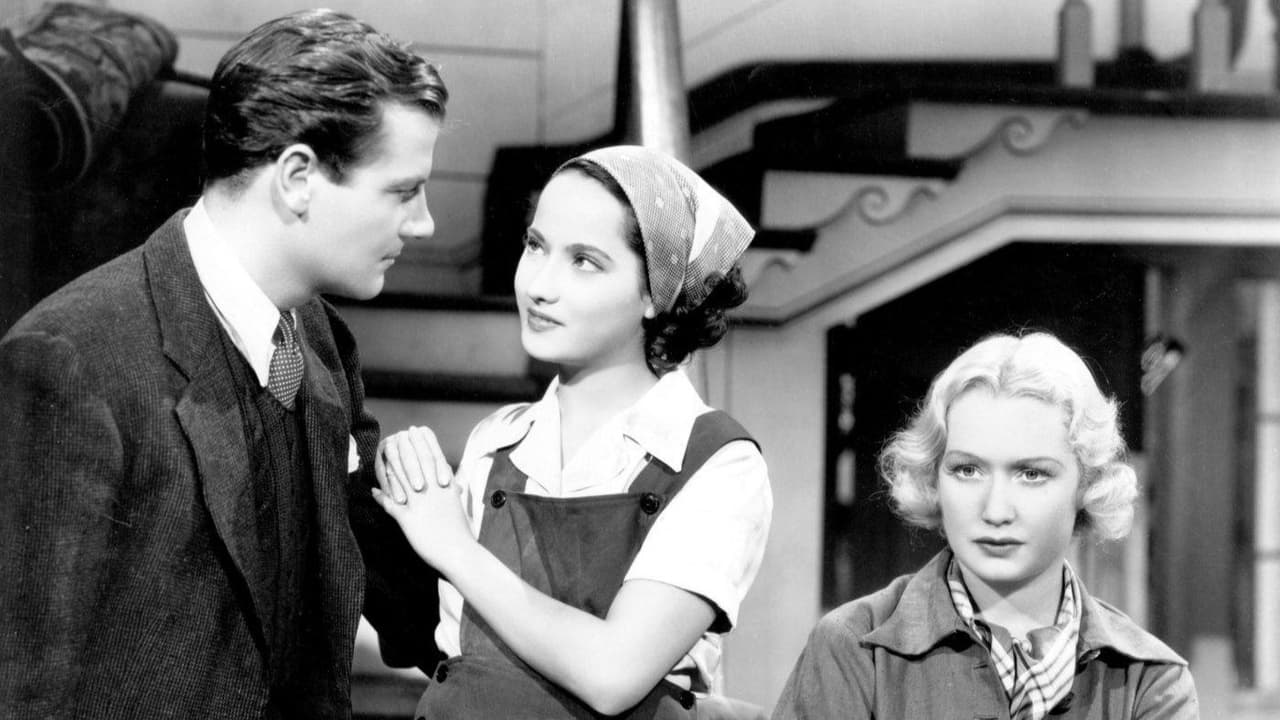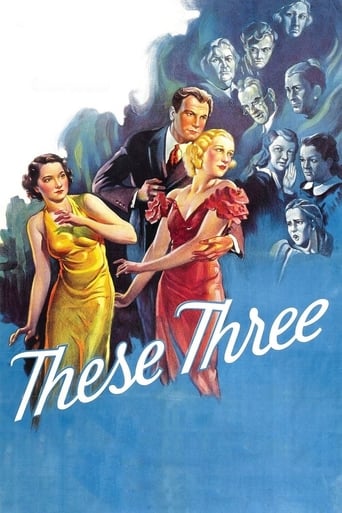

Just so...so bad
... View MoreI didn’t really have many expectations going into the movie (good or bad), but I actually really enjoyed it. I really liked the characters and the banter between them.
... View MoreIt is an exhilarating, distressing, funny and profound film, with one of the more memorable film scores in years,
... View MoreIt's a good bad... and worth a popcorn matinée. While it's easy to lament what could have been...
... View MoreThe "these three" of the title is a pretty mundane triangle with only Miriam Hopkins excelling as the sensitive Martha, caught up in a love affair between her dear friend Karen (Merle Oberon) and husky he-man, Dr. Cardin (Joel McCrea). What this film is remembered for are the spellbinding performances of the two young girls. Psychotic Mary Tilford was played by Bonita Granville who had been around since the early 30s, playing in films like "Silver Dollar" and "Cavalcade" (1933). Nothing prepared anyone for her knockout performance as Mary Tilford, a school yard bully supreme, who rules the weaker Rosalie (Marcia Mae Jones) through fear and intimidation. If anything Jones' portrayal is even more dynamic, as her Rosalie is pushed to the breaking point by being forced to betray a teacher she loves.Karen and Martha, friends and graduates of the same class, plan to set up a school in an old farm house that Karen has inherited. On their first day they meet charming Dr. Cardin and he is instantly attracted to Karen - shy Martha is also drawn to him. They also meet Mrs. Tilford, the most influential woman in the village - she is bringing her grand- daughter, Mary home from school (has she been expelled???) and suggests her as a pupil for their school. Mary becomes the school cheat and bully, singling out sweet Rosalie for her vicious attacks. Mary is fed up with what she feels is unfair treatment and runs away. She concocts a lie about the two teachers and Dr. Cardin and she tells her grandmother so she won't have to go back. The lie gets out of hand as Mrs Tilford is horrified and spreads the news around the town - suddenly parents are withdrawing their children from school and Karen and Martha don't know why!!! To clear their name they issue Mrs Tilford with a libel suit but, unfortunately, Mary is blackmailing Rosalie over the alleged theft of a missing bracelet, so she backs Mary's story and the teachers lose their case!!The power of both the children's performances is extraordinary. Marcia Mae Jones' Rosalie more than matches Bonita Granvilles' Mary in intensity and passion. By the end of the thirties Granville's roles were a far cry from Mary Tilford and she is remembered today for starring in a series built around that all American girl detective Nancy Drew. Marcia Mae Jones, who had been acting since she was a baby (her first role was as a baby in Dolores Costello's "Mannequin"(1926)) played memorable parts in 2 Shirley Temple movies (Klara in "Heidi" (1938) and a particularly horrible schoolgirl in "The Little Princess" (1939)) but nothing else of note. I think Miriam Hopkins portrayal of inhibited Martha is streets ahead of Merle Oberon' bland Karen but when the film was released they both received equal praise. Samuel Goldwyn, who thought this film would provide Miriam with the breakout role she needed, lost interest in her after this.Highly Recommended.
... View MoreThis engaging, often very powerful drama was director William Wyler's first big success. While Lilian Helman's controversial play "The Children's Hour" was censored of lesbian themes due to the Production Code, and made into a triangle drama of two women in love with the one man, this is still a marvellous adaptation. It's a compelling, frightening look at how lies and suspicion can ruin several lives. The three leads are Miriam Hopkins, Merle Oberon and Joel McCrea. Oberon was never much of an actress but she was usually passable enough on screen, and here she outdoes herself, thanks to a good director and meaty material. McCrea is her fiancé that she suspects is having an affair with Hopkins, and he too turns in solid work. Hopkins gives a subtle performance that rises to a fever pitch as the accusations fly. However, it's Bonita Granville's poisonous schoolgirl who tells the lie who is truly unforgettable. Her Mary is surely one of the most spiteful little creatures ever put on screen. When Margaret Hamilton slaps her, I bet everyone would applaud! And this is from an actress who was best known as The Wicked Witch Of The West! Wyler worked with cinematographer Gregg Toland in this film as he would in the later "Wuthering Heights", "The Little Foxes" and "The Best Years Of Our Lives", and it's fair to say they work dramatic magic together. Toland was developing his famed deep-focus here, and the "triangle composition" within the shot works very well. Overall, there's not much to fault. It takes a little while to get into it though.
... View MoreIn Lillian Hellman's original play, THE CHILDREN'S HOUR, the scandal involved lesbianism--certainly NOT a topic they were allowed to address in Hollywood in the strengthened Production Code era. Starting around 1935, Hollywood bowed to pressure to clean up the movies and feature more wholesome images. While today some see this as a totally negative thing, you must understand that nudity, violence, crudeness and very adult topics were frequently used in films and there was no rating system. So, kids might go to the theaters and see rather graphic nude swimming scenes (TARZAN AND HIS MATE and BIRD OF PARADISE are good examples) or Frank McHugh giving someone "the finger" (PARATROOPER). As a result, SOME sort of system needed to be created, though I will admit some of the resulting products from Hollywood were a bit bland. In regard to THE CHILDREN'S HOUR, there was no way the studios would be allowed to discuss homosexuality during this era, so they changed the allegations to promiscuity between a man and a woman. This did NOT appreciably alter the play nor its impact and reportedly Miss Hellman was happy with the film despite this minor change--minor in that it resulted in only minor alterations to the script and kept the overall message intact.The resulting film, THESE THREE, was produced by David O. Selznick, directed by William Wyler and starred Miriam Hopkins, Merle Oberon and Joel McCrea. With this terrific combination of talents and the Hellman script, it certainly isn't much of a surprise that the film was excellent throughout--and one of the better pictures of the 1930s. About the only negative at all about the play was the performance of young Bonita Granville. While generally very good (earning her an Oscar nomination), it was at times also a tad over-the-top--and she acted so histrionic that you wonder what sane person would believe all of her lies!!! If this had been toned down just a bit (making her a little more subtle), the film would have earned a 10. As it is, it's still a terrific film with an original and wonderful script.
... View MoreEveryone told Sam Goldwyn that he had to be crazy to buy the film rights to this one. At the time (1930s), the lesbian theme of the play would have made a film version impossible to release. But, Goldwyn and Lillian Hellman came up with a version that kept intact the other central theme (the vicious lie told by Mary Tilford, the young girl played by Bonita Granville and the resulting damage to "These Three" lives). Of interest to trivia buffs is the fact that Miriam Hopkins (known by many as a "difficult" actress in her Hollywood years), who played Martha in this version, was brought back to play Martha's aunt (Lily Mortar) in the later (1960s) William Wyler version, which reverted to the original title of THE CHILDREN'S HOUR, and starred Audrey Hepburn and Shirley MacLaine. That version also was graced by the brilliant performance of Fay Bainter, who played Mary Tilford's grandmother. Watch her especially closely as she exits, after making her (rejected)apology and offer of restitution. Want a real treat? Read Hellman's script for the Broadway play ... and then watch both film versions, in either order.
... View More